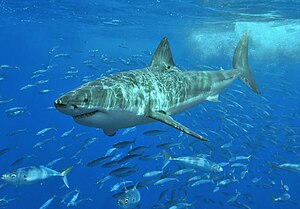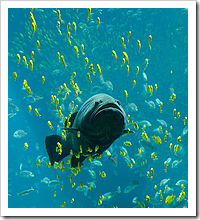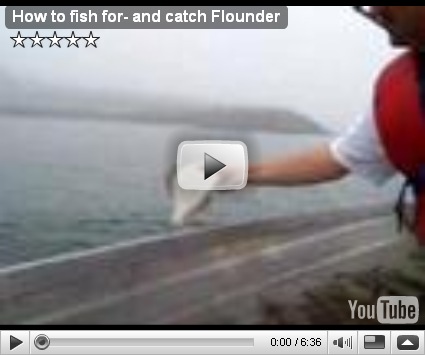
A landing net
A fishing net or fishnet is a net that is used for fishing. Fishing nets are meshes usually formed by knotting a relatively thin thread. Modern nets are usually made of artificial polyamides like nylon, although nets of organic polyamides such as wool or silk thread were common until recently and are still used.
Contents
-
1 Types of fishing nets
-
1.1 Hand net
-
1.2 Cast net
-
1.3 Coracle fishing
-
1.4 Chinese nets
-
1.5 Gillnet
-
1.6 Drift net
-
1.7 Ghost net
-
1.8 Stake net
-
1.9 Drive-in net
-
1.10 Fyke net
-
1.11 Trammel
-
1.12 Seine
-
1.13 Trawl
-
2 History
-
3 See also
-
4 Notes
-
5 References
-
6 External links
Types of fishing nets
Fishing for salmon with a hand net on the Fraser River, Canada
Casting a net in the Mahanadi River, India
Coracles net fishing on the River Teifi, Wales 1972.
Chinese fishing nets in Kerala, India
Hand net
Hand nets are held open by a hoop and are possibly on the end of a long stiff handle. They have been known since antiquity and may be used for sweeping up fish near the water surface like muskellunge and northern pike. When such a net is used by an angler to help land a fish it is known as a landing net.[1] In England, hand netting is the only legal way of catching eels and has been practised for thousands of years on the River Parrett and River Severn.
Cast net
Cast nets are small round nets with weights on the edges which is thrown by the fisher. Sizes vary up to about four metres in diameter. The net is thrown by hand in such a manner that it spreads out on the water and sinks. Fish are caught as the net is hauled back in.[2]
Coracle fishing
Coracle fishing is performed by two men, each seated in a coracle, plying his paddle with one hand and holding a shared net with the other. When a fish is caught, each hauls up his end of the net until the two coracles are brought to touch and the fish is secured.
Chinese nets
The Chinese fishing nets (Cheena vala) are used at Kochi in India. They are an example of shore operated lift nets[3] because they are held horizontally by a large fixed structure and periodically lowered into the water. Huge mechanical contrivances hold out horizontal nets with diameters of twenty metres or more. The nets are dipped into the water and raised again, but otherwise cannot be moved.
Gillnet
The gillnet catches fish which try to pass through it by snagging on the gill covers. Thus trapped, the fish can neither advance through the net nor retreat
Drift net
The drift net is a net that is not anchored. It is usually a gillnet, and is commonly used in the coastal waters of many countries.[4]. Its use on the high seas is prohibited, but still occurs.
Ghost net
Ghost nets are nets that have been lost at sea. They may continue to be a menace to marine life for many years.
Stake net
A stake net is a form of net for catching salmon. It consists of a sheet of network stretched on stakes fixed into the ground, generally in rivers or where the sea ebbs and flows, for entangling and catching the fish.
Drive-in net
A drive-in net is another fixed net, used by small-scale fishermen in some fisheries in Japan and South Asia, particularly in the Philippines. It is used to catch schooling forage fish such as fusiliers and other reef fish. It is a dustpan-shaped net, resembling a trawl net with long wings. The front part of the net is laid along the seabed. The fishermen either wait until a school swims into the net, or they
drive fish into it by creating some sort of commotion. Then the net is closed by lifting the front end so the fish cannot escape.
[5]
Fyke net
Three fykes at the Zuiderzeemuseum
Fyke nets are bag-shaped nets which are held open by hoops. These can be linked together in long chains, and are used to catch eels in rivers. If fyke nets are equipped with wings and leaders, they can also be used in sheltered places in lakes where there is plenty plant life. Hundreds of these nets can be connected into systems where it is not practical to build large traps.[6]
Trammel
A trammel is a fishing net set vertically in the water with three layers. The layers are made of finer meshes as they progress from the outer layer to the inner layer, in order to trap and pre-sort different fish.
Seine
A seine is a large fishing net that may be arranged in a number of different ways. In purse seine fishing the net hangs vertically in the water by attaching weights along the bottom edge and floats along the top. A simple and commonly used fishing technique is beach seining, where the seine net is operated from the shore. Danish seine is a method which has some similarities with trawling.
Trawl
A trawl is a large net, conical in shape, designed to be towed in the sea or along the sea bottom. The trawl is pulled through the water by one or more boats, called trawlers. The activity of pulling the trawl through the water is called trawling.
Fishermen in Bangladesh
A Moroccan fisherman mending his nets.
Fishing nets on a shrimp boat, Ostend, Belgium
Fishing with a cast net.
History
Between 177 and 180 the Greek author Oppian wrote the Halieutica, a didactic poem about fishing. He described various means of fishing including the use of nets cast from boats, scoop nets held open by a hoop, and various traps "which work while their masters sleep". Here is Oppian's description of fishing with a "motionless" net:
The fishers set up very light nets of buoyant flax and wheel in a circle round about while they violently strike the surface of the sea with their oars and make a din with sweeping blow of poles. At the flashing of the swift oars and the noise the fish bound in terror and rush into the bosom of the net which stands at rest, thinking it to be a shelter: foolish fishes which, frightened by a noise, enter the gates of doom. Then the fishers on either side hasten with the ropes to draw the net ashore.
Boat-shaped pot from the Ancient China Yangshao neolithic period (ca. 5000-3000 BC). The black fishnet design on this vessel, which was used to draw water, suggests that the Neolithic Chinese were already using nets to catch fish.
Fishing with a net, tacuinum sanitatis casanatensis (XIV century)
Albrecht Dürer c. 1490-1493

Medieval Scandinavian ice fishing technique (published 1555).
Pictorial evidence of Roman fishing comes from mosaics which show nets.
[7] In a parody of fishing, a type of gladiator called retiarius was armed with a trident and a casting-net. He would fight against the murmillo, who carried a short sword and a helmet with the image of a fish on the front.
In Norse mythology the sea giantess Rán uses a fishing net to trap lost sailors.
From Wikipedia
In the Book of Jonah a "great fish" swallowed Jonah the Prophet. Legends of half-human, half-fish mermaids have featured in stories like those of Hans Christian Andersen and movies like Splash (See Merman, Mermaid).
Among the deities said to take the form of a fish are Ika-Roa of the Polynesians, Dagon of various ancient Semitic peoples, and Matsya of the Dravidas of India. The astrological symbol Pisces is based on a constellation of the same name, but there is also a second fish constellation in the night sky, Piscis Austrinus.
Fish have been used figuratively in many different ways, for example the ichthys used by early Christians to identify themselves, through to the fish as a symbol of fertility among Bengalis.[61]

coat of arms of Comacchio, Italy

coat of arms of Narva, Estonia.
Fish have also featured prominently in art and literature, as in movies such as Finding Nemo and books such as The Old Man and the Sea. Large fish, particularly sharks, have frequently been the subject of horror movies and thrillers, most notably the novel Jaws, which spawned a series of films of the same name that in turn inspired similar films or parodies such as Shark Tale, Snakehead Terror, and Piranha.
The golden fish (Sanskrit: Matsya), represents in the semiotic of Ashtamangala,(buddhist symbolism) the state of fearless suspension in samsara, thus perceived as the harmless ocean, referred to as 'buddha-eyes' or ' rigpa-sight] '. The fishes symbolises the auspiciousness of all living beings in a state of fearlessness without danger of drowning in the Samsaric Ocean of Suffering, and migrating from teaching to teaching freely and spontaneously just as fish swim.
In the following quotation, the two golden fishes are linked with the Ganges and Yamuna, and nadi, prana and carp:
The two fishes originally represented the two main sacred rivers of India - the Ganges and Yamuna. These rivers are associated with the lunar and solar channels which originate in the nostrils and carry the alternating rhythms of breath & prana.

Fish riders is a 1920s poster of the Republic of China.
They have religious significance in Hindu, Jain and Buddhist traditions but also in Christianity who is first signified by the sign of the fish, and especially referring to feeding the multitude in the desert. In the dhamma of Buddha the fish symbolize happiness as they have complete freedom of movement in the water. They represent fertility and abundance. Often drawn in the form of carp which are regarded in the Orient as sacred on account of their elegant beauty, size and life-span.[3]

Anguilla coat of arms
The name of the Canadian city of Coquitlam, British Columbia is derived from Kwikwetlem, which is said to be derived from a Coast Salish term meaning "little red fish".[62]
From Wikipedia
Digestive system
The advent of jaws allowed fish to eat a much wider variety of food, including plants and other organisms. In fish, food is ingested through the mouth and then broken down in the esophagus. When it enters the stomach, the food is further broken down and, in many fish, further processed in finger-like pouches called pyloric caeca. The pyloric caeca secrete digestive enzymes and absorb nutrients from the digested food. Organs such as the liver and pancreas add enzymes and various digestive chemicals as the food moves through the digestive tract. The intestine completes the process of digestion and nutrient absorption.
Respiratory system
Most fish exchange gases by using gills that are located on either side of the pharynx. Gills are made up of threadlike structures called filaments. Each filament contains a network of capillaries that allow a large surface area for the exchange of oxygen and carbon dioxide. Fish exchange gases by pulling oxygen-rich water through their mouths and pumping it over their gill filaments. The blood in the capillaries flows in the opposite direction to the water, causing counter current exchange. They then push the oxygen-poor water out through openings in the sides of the pharynx. Some fishes, like sharks and lampreys, possess multiple gill openings. However, most fishes have a single gill opening on each side of the body. This opening is hidden beneath a protective bony cover called an operculum.
Juvenile bichirs have external gills, a very primitive feature that they hold in common with larval amphibians.

Swim bladder of a Rudd (Scardinius erythrophthalmus)
Many fish can breathe air. The mechanisms for doing so are varied. The skin of anguillid eels may be used to absorb oxygen. The buccal cavity of the electric eel may be used to breathe air. Catfishes of the families Loricariidae, Callichthyidae, and Scoloplacidae are able to absorb air through their digestive tracts.[14] Lungfish and bichirs have paired lungs similar to those of tetrapods and must rise to the surface of the water to gulp fresh air in through the mouth and pass spent air out through the gills. Gar and bowfin have a vascularised swim bladder that is used in the same way. Loaches, trahiras, and many catfish breathe by passing air through the gut. Mudskippers breathe by absorbing oxygen across the skin (similar to what frogs do). A number of fishes have evolved so-called accessory breathing organs that are used to extract oxygen from the air. Labyrinth fish (such as gouramis and bettas) have a labyrinth organ above the gills that performs this function. A few other fish have structures more or less resembling labyrinth organs in form and function, most notably snakeheads, pikeheads, and the Clariidae family of catfish.
Being able to breathe air is primarily of use to fish that inhabit shallow, seasonally variable waters where the oxygen concentration in the water may decline at certain times of the year. At such times, fishes dependent solely on the oxygen in the water, such as perch and cichlids, will quickly suffocate, but air-breathing fish can survive for much longer, in some cases in water that is little more than wet mud. At the most extreme, some of these air-breathing fish are able to survive in damp burrows for weeks after the water has otherwise completely dried up, entering a state of aestivation until the water returns.

Tuna gills inside of the head. The fish head is oriented snout-downwards, with the view looking towards the mouth.
Fish can be divided into obligate air breathers and facultative air breathers. Obligate air breathers, such as the African lungfish, must breathe air periodically or they will suffocate. Facultative air breathers, such as the catfish Hypostomus plecostomus, will only breathe air if they need to and will otherwise rely solely on their gills for oxygen if conditions are favourable. Most air breathing fish are not obligate air breathers, as there is an energetic cost in rising to the surface and a fitness cost of being exposed to surface predators.[14]
Circulatory system
Fish have a closed circulatory system with a heart that pumps the blood in a single loop throughout the body. The blood goes from the heart to gills, from the gills to the rest of the body, and then back to the heart. In most fish, the heart consists of four parts: the sinus venosus, the atrium, the ventricle, and the bulbus arteriosus. Despite consisting of four parts, the fish heart is still a two-chambered heart.[15] The sinus venosus is a thin-walled sac that collects blood from the fish's veins before allowing it to flow to the atrium, which is a large muscular chamber. The atrium serves as a one-way compartment for blood to flow into the ventricle. The ventricle is a thick-walled, muscular chamber and it does the actual pumping for the heart. It pumps blood to a large tube called the bulbus arteriosus. At the front end, the bulbus arteriosus connects to a large blood vessel called the aorta, through which blood flows to the fish's gills.
Excretory system
As with many aquatic animals, most fish release their nitrogenous wastes as ammonia. Some of the wastes diffuse through the gills into the surrounding water. Others are removed by the kidneys, excretory organs that filter wastes from the blood. Kidneys help fishes control the amount of ammonia in their bodies. Saltwater fish tend to lose water because of osmosis. In salt-water fish, the kidneys concentrate wastes and return as much water as possible back to the body. The reverse happens in freshwater fish: they tend to gain water continuously. The kidneys of freshwater fish are specially adapted to pump out large amounts of dilute urine. Some fish have specially adapted kidneys that change their function, allowing them to move from freshwater to salt-water.
Scales
Main article: Scale (zoology)#Fish scales
The scales of fish originate from the mesoderm (skin); they may be similar in structure to teeth.
Sensory and nervous system

Dorsal view of the brain of the rainbow trout.
Central nervous system
Fish typically have quite small brains relative to body size when compared with other vertebrates, typically one-fifteenth the mass of the brain from a similarly sized bird or mammal.[16] However, some fish have relatively large brains, most notably mormyrids and sharks, which have brains of about as massive relative to body weight as birds and marsupials.[17]
The brain is divided into several regions. At the front are the olfactory lobes, a pair of structure the receive and process signals from the nostrils via the two olfactory nerves.[16] The olfactory lobes are very large in fishes that hunt primarily by smell, such as hagfish, sharks, and catfish. Behind the olfactory lobes is the two-lobed telencephalon, the equivalent structure to the cerebrum in higher vertebrates. In fishes the telencephalon is concerned mostly with olfaction.[16] Together these structures form the forebrain.
Connecting the forebrain to the midbrain is the diencephalon (in the adjacent diagram, this structure is below the optic lobes and consequently not visible). The diencephalon performs a number of functions associated with hormones and homeostasis.[16] The pineal body lies just above the diencephalon. This structure performs many different functions including detecting light, maintaining circadian rhythms, and controlling colour changes.[16]
The midbrain or mesencephalon contains the two optic lobes. These are very large in species that hunt by sight, such as rainbow trout and cichlids.[16]
The hindbrain or metencephalon is particularly involved in swimming and balance.[16] The cerebellum is a single-lobed structure that is usually very large, typically the biggest part of the brain.[16] Hagfish and lampreys have relatively small cerebellums, but at the other extreme the cerebellums of mormyrids are massively developed and apparently involved in their electrical sense.[16]
The brain stem or myelencephalon is the most posterior part of the brain.[16] As well as controlling the functions of some of the muscles and body organs, in bony fish at least the brain stem is also concerned with respiration and osmoregulation.[16]
Sense organs
Most fish possess highly developed sense organs. Nearly all daylight fish have well-developed eyes that have color vision that is at least as good as a human's. Many fish also have specialized cells known as chemoreceptors that are responsible for extraordinary senses of taste and smell. Although they have ears in their heads, many fish may not hear sounds very well. However, most fishes have sensitive receptors that form the lateral line system. The lateral line system allows for many fish to detect gentle currents and vibrations, as well as to sense the motion of other nearby fish and prey.[18] Some fish, such as catfish and sharks, have organs that detect low levels electric current.[19] Other fish, like the electric eel, can produce their own electricity.
Fish orient themselves using landmarks and may use mental maps of geometric relationships based on multiple landmarks or symbols. By studying fish in mazes, it has been determined that fish routinely use spacial memory and visual discrimination.[20]
Capacity for pain
Further information: Pain in fish
Experiments done by William Tavolga provide evidence that fish have pain and fear responses. For instance, in Tavolga’s experiments, toadfish grunted when electrically shocked and over time they came to grunt at the mere sight of an electrode.[21]
In 2003, Scottish scientists at the University of Edinburgh performing research on rainbow trout concluded that fish exhibit behaviors often associated with pain. At tests conducted at both the University of Edinburgh and the Roslin Institute, bee venom and acetic acid were injected into the lips of rainbow trout, resulted in fish rocking their bodies and rubbing their lips along the sides and floors of their tanks, which the researchers believe were efforts to relieve themselves of pain similar to what mammals would also do.[22][23][24] Neurons in the brains of the fish fired in a pattern resembling that of humans when they experience pain.[24]
Professor James D. Rose of the University of Wyoming critiqued the study, claiming it was flawed, mainly since it did not provide proof that fish possess "conscious awareness, particularly a kind of awareness that is meaningfully like ours".[25] Rose argues that since the fish brain is rather different from ours, fish are probably not conscious (in the manner humans are), whence reactions similar to human reactions to pain instead have other causes. Rose had published his own opinion a year earlier arguing that fish cannot feel pain as their brains lack a neocortex.[26] However, animal behaviorist Temple Grandin argues that fish could still have consciousness without a neocortex because "different species can use different brain structures and systems to handle the same functions."[24]
Animal protection advocates have raised concerns about the possible suffering of fish caused by angling. In light of recent research, some countries, like Germany, have banned specific types of fishing, and the British RSPCA now formally prosecutes individuals who are cruel to fish.[27]
Muscular system
Main article: Fish locomotion
Most fish move by contracting paired sets of muscles on either side of the backbone alternately. These contractions form S-shaped curves that move down the body of the fish. As each curve reaches the back fin, backward force is created. This backward force, in conjunction with the fins, moves the fish forward. The fish's fins are used like an airplane's stabilizers. Fins also increase the surface area of the tail, allowing for an extra boost in speed. The streamlined body of the fish decreases the amount of friction as they move through water. Since body tissue is denser than water, fish must compensate for the difference or they will sink. Many bony fishes have an internal organ called a swim bladder that adjusts their buoyancy through manipulation of gases.
Homeothermy

A 3 to 4 m great white shark off Isla Guadalupe
Although most fish are exclusively aquatic and ectothermic, there are exceptions to both cases.
Fish from a number of different groups have evolved the capacity to live out of the water for extended periods of time. Of these amphibious fish, some such as the mudskipper can live and move about on land for up to several days.
Also, certain species of fish maintain elevated body temperatures to varying degrees. Endothermic teleosts (bony fishes) are all in the suborder Scombroidei and include the billfishes, tunas, and one species of "primitive" mackerel (Gasterochisma melampus). All sharks in the family Lamnidae – shortfin mako, long fin mako, white, porbeagle, and salmon shark – are known to have the capacity for endothermy, and evidence suggests the trait exists in family Alopiidae (thresher sharks). The degree of endothermy varies from the billfish, which warm only their eyes and brain, to bluefin tuna and porbeagle sharks who maintain body temperatures elevated in excess of 20 °C above ambient water temperatures. See also gigantothermy. Endothermy, though metabolically costly, is thought to provide advantages such as increased contractile force of muscles, higher rates of central nervous system processing, and higher rates of digestion.
Reproductive system
Further information: Spawn (biology)
Organs

Organs: 1. Liver, 2. Gas bladder, 3. Roe, 4. Pyloric caeca, 5. Stomach, 6. Intestine
Fish reproductive organs include testes and ovaries. In most fish species, gonads are paired organs of similar size, which can be partially or totally fused.[28] There may also be a range of secondary reproductive organs that help in increasing a fish's fitness.
In terms of spermatogonia distribution, the structure of teleosts testes has two types: in the most common, spermatogonia occur all along the seminiferous tubules, while in Atherinomorph fishes they are confined to the distal portion of these structures. Fishes can present cystic or semi-cystic spermatogenesis in relation to the phase of release of germ cells in cysts to the seminiferous tubules lumen.[28]
Fish ovaries may be of three types: gymnovarian, secondary gymnovarian or cystovarian. In the first type, the oocytes are released directly into the coelomic cavity and then enter the ostium, then through the oviduct and are eliminated. Secondary gymnovarian ovaries shed ova into the coelom and then they go directly into the oviduct. In the third type, the oocytes are conveyed to the exterior through the oviduct.[29] Gymnovaries are the primitive condition found in lungfishes, sturgeons, and bowfins. Cystovaries are the condition that characterizes most of the teleosts, where the ovary lumen has continuity with the oviduct.[28] Secondary gymnovaries are found in salmonids and a few other teleosts.
Oogonia development in teleosts fish varies according to the group, and the determination of oogenesis dynamics allows the understanding of maturation and fertilization processes. Changes in the nucleus, ooplasm, and the surrounding layers characterize the oocyte maturation process.[28]
Postovulatory follicles are structures formed after oocyte release; they do not have endocrine function, present a wide irregular lumen, and are rapidly reabosrbed in a process involving the apoptosis of follicular cells. A degenerative process called follicular atresia reabsorbs vitellogenic oocytes not spawned. This process can also occur, but less frequently, in oocytes in other development stages.[28]
Some fish are hermaphrodites, having testes and ovaries either at different phases in their life cycle or, like hamlets, can be simultaneously male and female.
Reproductive method
Over 97% of all known fishes are oviparous,[30] that is, the eggs develop outside the mother's body. Examples of oviparous fishes include salmon, goldfish, cichlids, tuna, and eels. In the majority of these species, fertilisation takes place outside the mother's body, with the male and female fish shedding their gametes into the surrounding water. However, a few oviparous fishes practise internal fertilisation, with the male using some sort of intromittent organ to deliver sperm into the genital opening of the female, most notably the oviparous sharks, such as the horn shark, and oviparous rays, such as skates. In these cases, the male is equipped with a pair of modified pelvic fins known as claspers.
Marine fish can produce high numbers of eggs which are often released into the open water column. The eggs have an average diameter of 1mm.

Egg of lamprey

Egg of catshark (mermaids' purses)

Egg of shark (?)

Egg of chimaera

An example of zooplankton
The newly-hatched young of oviparous fish are called larvae. They are usually poorly formed, carry a large yolk sac (from which they gain their nutrition) and are very different in appearance to juvenile and adult specimens of their species. The larval period in oviparous fish is relatively short however (usually only several weeks), and larvae rapidly grow and change appearance and structure (a process termed metamorphosis) to resemble juveniles of their species. During this transition larvae use up their yolk sac and must switch from yolk sac nutrition to feeding on zooplankton prey, a process which is dependent on zooplankton prey densities and causes many mortalities in larvae.
Ovoviviparous fish are ones in which the eggs develop inside the mother's body after internal fertilization but receive little or no nutrition from the mother, depending instead on the yolk. Each embryo develops in its own egg. Familiar examples of ovoviviparous fishes include guppies, angel sharks, and coelacanths.
Some species of fish are viviparous. In such species the mother retains the eggs, as in ovoviviparous fishes, but the embryos receive nutrition from the mother in a variety of different ways. Typically, viviparous fishes have a structure analogous to the placenta seen in mammals connecting the mother's blood supply with the that of the embryo. Examples of viviparous fishes of this type include the surf-perches, splitfins, and lemon shark. The embryos of some viviparous fishes exhibit a behaviour known as oophagy where the developing embryos eat eggs produced by the mother. This has been observed primarily among sharks, such as the shortfin mako and porbeagle, but is known for a few bony fish as well, such as the halfbeak Nomorhamphus ebrardtii.[31] Intrauterine cannibalism is an even more unusual mode of vivipary, where the largest embryos in the uterus will eat their weaker and smaller siblings. This behaviour is also most commonly found among sharks, such as the grey nurse shark, but has also been reported for Nomorhamphus ebrardtii.[31]
Aquarists commonly refer to ovoviviparous and viviparous fishes as livebearers.
Immune system
Types of immune organs vary between different types of fish.[32] In the jawless fish (lampreys and hagfishes), true lymphoid organs are absent. Instead, these fish rely on regions of lymphoid tissue within other organs to produce their immune cells. For example, erythrocytes, macrophages and plasma cells are produced in the anterior kidney (or pronephros) and some areas of the gut (where granulocytes mature) resemble primitive bone marrow in hagfish. Cartilaginous fish (sharks and rays) have a more advanced immune system than the jawless fish. They have three specialized organs that are unique to chondrichthyes; the epigonal organs (lymphoid tissue similar to bone marrow of mammals) that surround the gonads, the Leydig's organ within the walls of their esophagus, and a spiral valve in their intestine. All these organs house typical immune cells (granulocytes, lymphocytes and plasma cells). They also possess an identifiable thymus and a well-developed spleen (their most important immune organ) where various lymphocytes, plasma cells and macrophages develop and are stored. Chondrostean fish (sturgeons, paddlefish and birchirs) possess a major site for the production of granulocytes within a mass that is associated with the meninges (membranes surrounding the central nervous system) and their heart is frequently covered with tissue that contains lymphocytes, reticular cells and a small number of macrophages. The chondrostean kidney is an important hemopoietic organ; where erythrocytes, granulocytes, lymphocytes and macrophages develop. Like chondrostean fish, the major immune tissues of bony fish (or teleostei) include the kidney (especially the anterior kidney), where many different immune cells are housed.[33] In addition, teleost fish possess a thymus, spleen and scattered immune areas within mucosal tissues (e.g. in the skin, gills, gut and gonads). Much like the mammalian immune system, teleost erythrocytes, neutrophils and granulocytes are believed to reside in the spleen whereas lymphocytes are the major cell type found in the thymus.[34][35] Recently, a lymphatic system similar to that described in mammals was described in one species of teleost fish, the zebrafish. Although not confirmed as yet, this system presumably will be where naive (unstimulated) T cells will accumulate while waiting to encounter an antigen.[36]
From Wikipedia


The term "fish" is most precisely used to describe any non-tetrapod chordate, (i.e., an animal with a backbone), that has gills throughout life and has limbs, if any, in the shape of fins.
[1] Unlike groupings such as birds or mammals, fish are not a single clade but a paraphyletic collection of taxa, including hagfishes, lampreys, sharks and rays, ray-finned fishes

, coelacanths, and lungfishes.
[2][3]
A typical fish is ectothermic, has a streamlined body that allows it to swim rapidly, extracts oxygen from the water using gills or an accessory breathing organ to enable it to breathe atmospheric oxygen, has two sets of paired fins, usually one or two (rarely three) dorsal fins, an anal fin, and a tail fin, has jaws, has skin that is usually covered with scales, and lays eggs that are fertilized internally or externally.
Fish come in many shapes and sizes. This is a sea dragon, a close relative of the seahorse. Their leaf-like appendages enable them to blend in with floating seaweed.
To each of these there are exceptions. Tuna, swordfish, and some species of sharks show some warm-blooded adaptations, and are able to raise their body temperature significantly above that of the ambient water surrounding them.
[4] Streamlining and swimming performance varies from highly streamlined and rapid swimmers which are able to reach 10–20 body-lengths per second (such as tuna, salmon, and jacks) through to slow but more maneuverable species such as eels and rays that reach no more than 0.5 body-lengths per second.
[5] Many groups of freshwater fish extract oxygen from the air as well as from the water using a variety of different structures. Lungfish have paired lungs similar to those of tetrapods, gouramis have a structure called the labyrinth organ that performs a similar function, while many
catfish, such as
Corydoras extract oxygen via the intestine or stomach.
[6] Body shape and the arrangement of the fins is highly variable, covering such seemingly un-fishlike forms as seahorses, pufferfish, anglerfish, and gulpers. Similarly, the surface of the skin may be naked (as in moray eels), or covered with scales of a variety of different types usually defined as placoid (typical of sharks and rays), cosmoid (fossil lungfishes and coelacanths), ganoid (various fossil fishes but also living gars and bichirs, cycloid, and ctenoid (these last two are found on most bony fish.
[7] There are even fishes that spend most of their time out of water. Mudskippers feed and interact with one another on mudflats and are only underwater when hiding in their burrows.
[8] The catfish
Phreatobius cisternarum lives in underground, phreatic habitats, and a relative lives in waterlogged leaf litter.
[9][10]
Fish range in size from the 16 m (51 ft) whale shark to the 8 mm (just over ¼ of an inch) long stout infantfish.
Many types of aquatic animals commonly referred to as "fish" are not fish in the sense given above; examples include shellfish, cuttlefish, starfish, crayfish and jellyfish. In earlier times, even biologists did not make a distinction - sixteenth century natural historians classified also seals, whales, amphibians, crocodiles, even hippopotamuses, as well as a host of aquatic invertebrates, as fish.[11] In some contexts, especially in aquaculture, the true fish are referred to as finfish (or fin fish) to distinguish them from these other animals.
From Wikipedia
 As you clock more and more bass fishing hours you will acquire a knack for choosing the right lure and technique for the right situation. The best advice is to examine the fishing conditions, ask for guidance from anglers familiar with the waters you are fishing, and, finally, to try many different lures and bass fishing techniques until you discover what works most effectively.
As you clock more and more bass fishing hours you will acquire a knack for choosing the right lure and technique for the right situation. The best advice is to examine the fishing conditions, ask for guidance from anglers familiar with the waters you are fishing, and, finally, to try many different lures and bass fishing techniques until you discover what works most effectively.


















 Ukha (Russian: Уха)
Ukha (Russian: Уха)




 As of 2006, the IUCN Red List describes 1,173 species of fish as being threatened with extinction.[44] Included on this list are species such as Atlantic cod,[45] Devil's Hole pupfish,[46] coelacanths,[47] and great white sharks.[48] Because fish live underwater they are much more difficult to study than terrestrial animals and plants, and information about fish populations is often lacking. However, freshwater fish seem particularly threatened because they often live in relatively small areas. For example, the Devil's Hole pupfish occupies only a single 3 m by 6 m pool.[49]
As of 2006, the IUCN Red List describes 1,173 species of fish as being threatened with extinction.[44] Included on this list are species such as Atlantic cod,[45] Devil's Hole pupfish,[46] coelacanths,[47] and great white sharks.[48] Because fish live underwater they are much more difficult to study than terrestrial animals and plants, and information about fish populations is often lacking. However, freshwater fish seem particularly threatened because they often live in relatively small areas. For example, the Devil's Hole pupfish occupies only a single 3 m by 6 m pool.[49]








 A fish is any aquatic vertebrate animal that is typically ectothermic (or cold-blooded), covered with scales, and equipped with two sets of paired fins and several unpaired fins. Fish are abundant in the sea and in fresh water, with species being known from mountain streams (e.g., char and gudgeon) as well as in the deepest depths of the ocean (e.g., gulpers and anglerfish).
A fish is any aquatic vertebrate animal that is typically ectothermic (or cold-blooded), covered with scales, and equipped with two sets of paired fins and several unpaired fins. Fish are abundant in the sea and in fresh water, with species being known from mountain streams (e.g., char and gudgeon) as well as in the deepest depths of the ocean (e.g., gulpers and anglerfish).

 The term "fish" is most precisely used to describe any non-tetrapod chordate, (i.e., an animal with a backbone), that has gills throughout life and has limbs, if any, in the shape of fins.[1] Unlike groupings such as birds or mammals, fish are not a single clade but a paraphyletic collection of taxa, including hagfishes, lampreys, sharks and rays, ray-finned fishes
The term "fish" is most precisely used to describe any non-tetrapod chordate, (i.e., an animal with a backbone), that has gills throughout life and has limbs, if any, in the shape of fins.[1] Unlike groupings such as birds or mammals, fish are not a single clade but a paraphyletic collection of taxa, including hagfishes, lampreys, sharks and rays, ray-finned fishes





.jpg)
.jpg)
